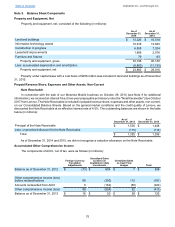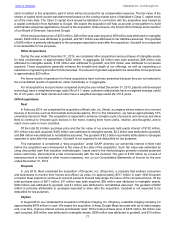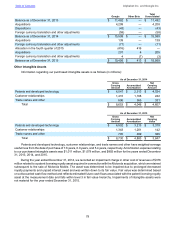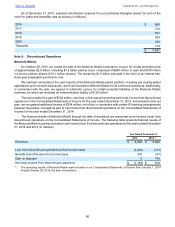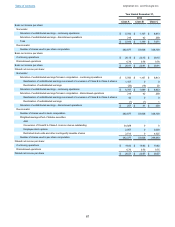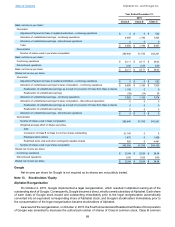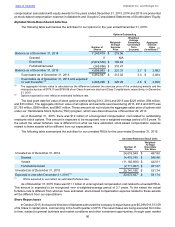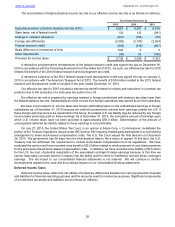Google 2015 Annual Report Download - page 89
Download and view the complete annual report
Please find page 89 of the 2015 Google annual report below. You can navigate through the pages in the report by either clicking on the pages listed below, or by using the keyword search tool below to find specific information within the annual report.
Table of Contents Alphabet Inc. and Google Inc.
85
material effect on our results of operations. If events occur which indicate payment of these amounts is unnecessary,
the reversal of the liabilities would result in the recognition of benefits in the period we determine the liabilities are no
longer necessary. If our estimates of the federal, state, and foreign income tax liabilities and indirect tax liabilities are
less than the ultimate assessment, it would result in a further charge to expense.
Please see Note 15 for additional information regarding contingencies related to our income taxes.
Note 12. Net Income Per Share
Alphabet
We compute net income per share of Class A and Class B common stock and Class C capital stock using the
two-class method. Basic net income per share is computed using the weighted-average number of common shares
outstanding during the period. Diluted net income per share is computed using the weighted-average number of
common shares and the effect of potentially dilutive securities outstanding during the period. Potentially dilutive
securities consist of stock options, restricted stock units, and other contingently issuable shares. The dilutive effect of
outstanding stock options, restricted stock units, and other contingently issuable shares is reflected in diluted earnings
per share by application of the treasury stock method. The computation of the diluted net income per share of Class A
common stock assumes the conversion of Class B common stock, while the diluted net income per share of Class B
common stock does not assume the conversion of those shares.
The rights, including the liquidation and dividend rights, of the holders of our Class A and Class B common stock
and Class C capital stock are identical, except with respect to voting. Further, there are a number of safeguards built
into our certificate of incorporation, as well as Delaware law, which preclude our board of directors from declaring or
paying unequal per share dividends on our Class A and Class B common stock and Class C capital stock. Specifically,
Delaware law provides that amendments to our certificate of incorporation which would have the effect of adversely
altering the rights, powers, or preferences of a given class of stock must be approved by the class of stock adversely
affected by the proposed amendment. In addition, our certificate of incorporation provides that before any such
amendment may be put to a stockholder vote, it must be approved by the unanimous consent of our board of directors.
As a result, the undistributed earnings for each year are allocated based on the contractual participation rights of the
Class A and Class B common shares and Class C capital stock as if the earnings for the year had been distributed.
As the liquidation and dividend rights are identical, the undistributed earnings are allocated on a proportionate basis.
The net income per share amounts are the same for Class A and Class B common stock and Class C capital stock
because the holders of each class are legally entitled to equal per share distributions whether through dividends or in
liquidation. Further, as we assume the conversion of Class B common stock in the computation of the diluted net
income per share of Class A common stock, the undistributed earnings are equal to net income for that computation.
Stock Split Effected In Form of Stock Dividend
In January 2014, our board of directors approved the distribution of shares of Class C capital stock as a dividend
to our holders of Class A and Class B common stock (the Stock Split). The Stock Split had a record date of March 27,
2014 and a payment date of April 2, 2014.
In the second quarter of 2015, in accordance with a settlement of litigation involving the authorization to distribute
Class C capital stock, at the close of trading on April 2, 2015, the last trading day of the 365 day period following the
first date the Class C shares traded on NASDAQ (Lookback Period), we determined that a payment (the Adjustment
Payment) in the amount of $522 million was due to Class C capital stockholders. The amount of the Adjustment
Payment was based on the percentage difference that developed between the volume-weighted average price of Class
A and Class C shares during the Lookback Period, as supplied by NASDAQ Data-on-Demand, and was payable to
holders of Class C capital stock as of the end of the Lookback Period in cash, Class A common stock, Class C capital
stock, or a combination thereof, at the discretion of our board of directors. On April 22, 2015, our board of directors
approved the Adjustment Payment in shares of Class C capital stock, and cash in lieu of any fractional shares of Class
C capital stock. In May 2015, the Adjustment Payment was made, resulting in the issuance of approximately 853
thousand shares of Class C capital stock, with $475 million reflected in additional-paid in capital and $47 million of
cash in lieu of fractional shares of Class C capital stock.
In the year ended December 31, 2015, the Adjustment Payment was allocated to the numerator for calculating
net income per share of Class C capital stock from net income available to all stockholders and the remaining
undistributed earnings were allocated on a pro rata basis to Class A and Class B common stock and Class C capital
stock based on the number of shares used in the per share computation for each class of stock. The weighted-average
share impact of the Adjustment Payment is included in the denominator of both basic and diluted net income per share
computations for the year ended December 31, 2015.


